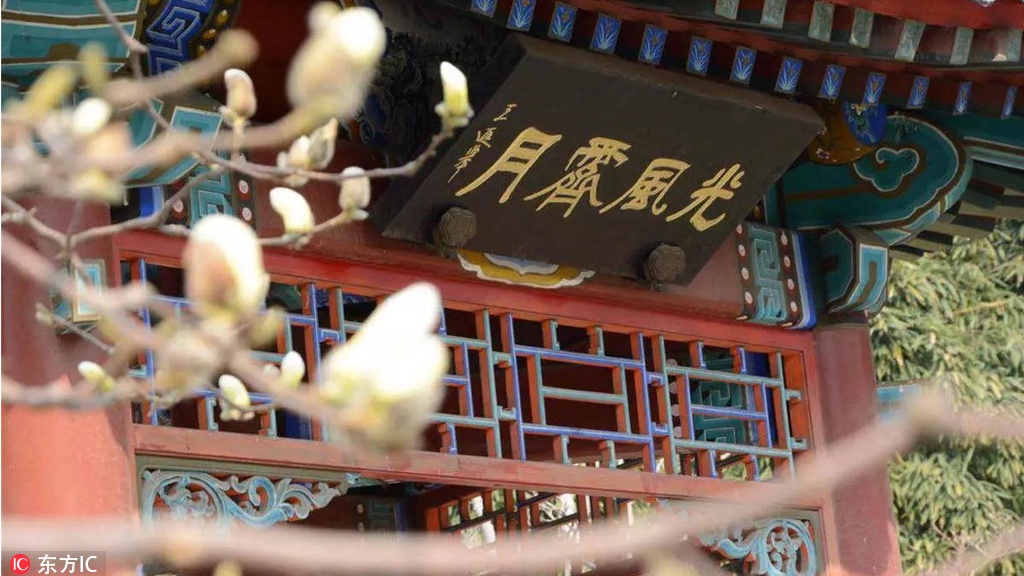Temple of the Moon

Yuetan Park is the seat of the Temple of the Moon in the Ming and Qing Dynasties (1368 - 1911). Originally named Xiyue (the moon at night) Altar. It was the place where emperors of Ming and Qing Dynasties offered sacrifice to the God of the Moon and the Gods of the Stars. The temple was built during the reign of emperor Jiajing of the Ming dynasty with a square platform measuring 5 feet (1.5 meters) high and 16 square yards (13 square meters). It is glazed all in white and it has six steps. There are four Lingxing gates. Yi Chi is in the outside of the east gate, Dressing Hall is in the northwest; Divine Depot is in the outside of the south gate, the Sacrifice Pavilion, Divine Kitchen and Sacrificial Library are in the southwest; Bell Tower and Heritage House are outside the north gate. There are two Outer Heavenly Gates. Outside of the East Heavenly Gate, the Ritual God workshop is to its south. The altar is paved with white glaze symbolizing the moon.
The emperors sacrifice the moon annually at Haishi (the period of the day from 9 p m to 11 p m) in the Autumn Equinox. The main sacrifice is to the Nocturnal God, and then they sacrifice the lunar mansions, the five stars of metal wood water fire and earth, and all the stars. The ancient people gave profound names to the moon by detailed observation of it. The last day of each month is the Dark Moon, the first day is the New Moon. “Xian” is the name of the half moon, and the full moon is named “Wang” with a meaning of far away from each other for the sun is in the East, and the moon is in the West. According to legend, the driver of the moon-car is called Lunalhx, also known as Xian’a. But because of the passing of years, the altar has disappeared.
Yuetan Park covers an area of 8.12 hectares, divided into South Park and North Park. The ancient building of the park is the object of cultural relic protection at the municipal level. The garden is one of the famous classical gardens in the capital, with a large number of ornamental trees, such as pine and cypress trees, pipal trees, pomegranate trees, osmanthus trees and so on. The North Park is the very seat of the Temple of the Moonin the Ming and Qing dynasties which is characterized by ancient architecture of red brick and green tile and regular roads.
As a new scenic area, the south section of the Temple of the Moon is a pattern of natural landscapes composed by hills, rocks, ponds and roundabout paths. The moon-themed park is also named “Yaoyue (Inviting the Moon) Garden”. A set of courtyards standing in the central Yaoyue Garden is collectively called “Tianxiang Courtyard”, signifying the fragrance of osmanthus flowers brimming with the courtyard. Besides, several stone rabbits are scattered on the wide lawn in the south of Tianxiang Courtyard. This design symbolizes the Guanghan Palace (Moon Palace) on earth.
Main scenic spots: the ancient buildings such as the Bell Tower, Holy Gate, Jufu Hall (Changing Palace), Shen Chu (Holy Kitchen) and Shen Ku (Holy Storehouse), as well as the newly-built Toad Palace, Double-loop Moon Mirroring Pond, Guanghan Bridge, Statute of Chang’e Flying to the Moon, Tianxiang Courtyard, Lanyue Pavilion, Moon Pavilion, Shuangyue Pavilion, and Yuegui Pavilion.
Address: No. 6, Yuetan North Street, Xicheng District西城区月坛北街甲6号
Traffic: Take bus No. 3, No. 13, No. 15, No. 19, No. 42, No. 56 or No. 12 (night)



